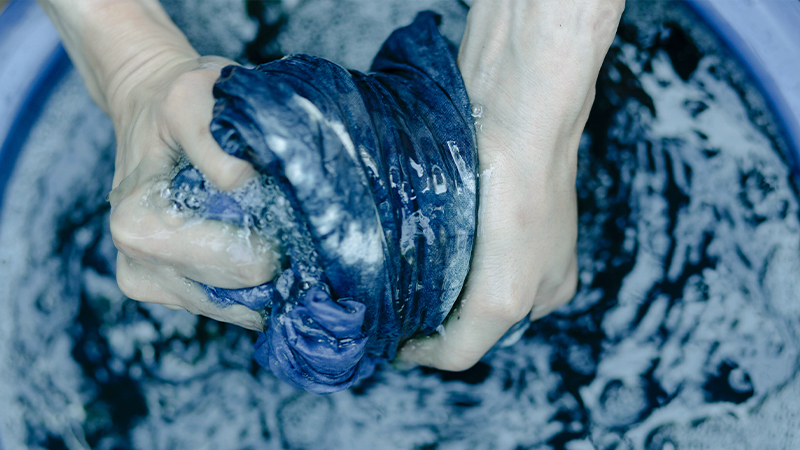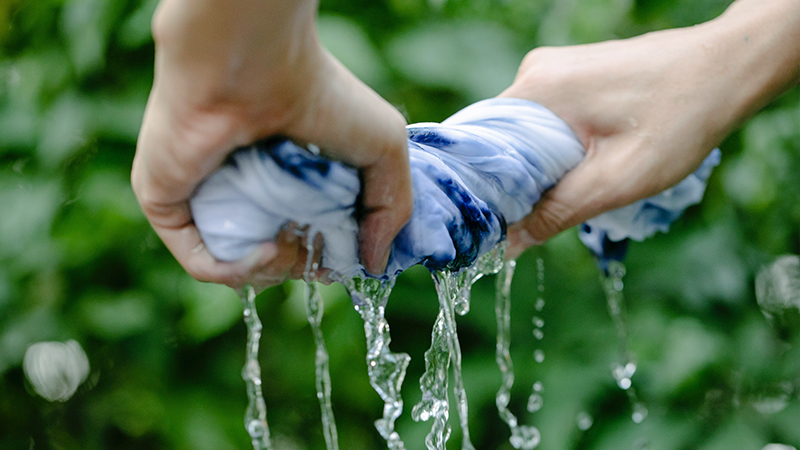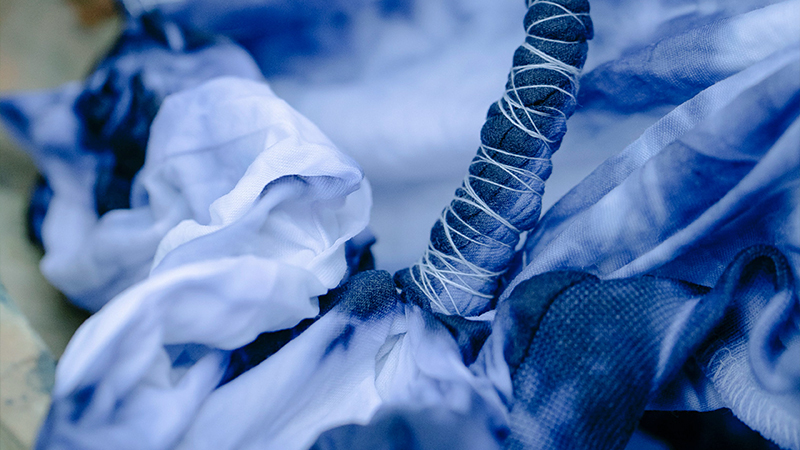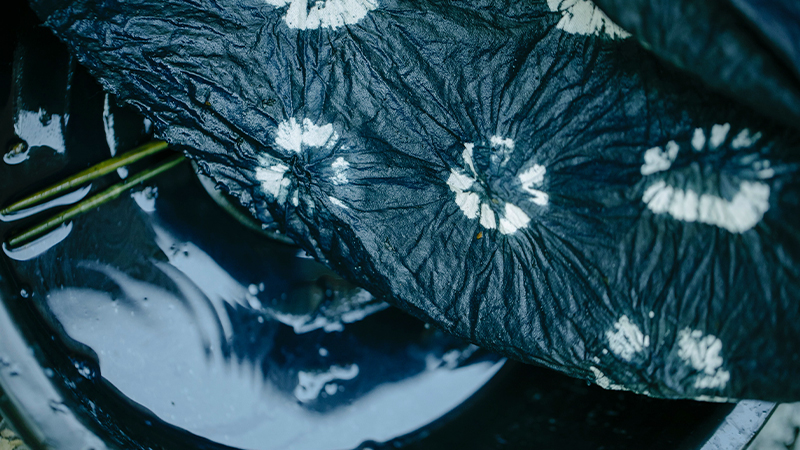Tie-dyeing is a vibrant and artistic way to transform plain fabrics into eye-catching creations. However, to ensure your tie-dye project maintains its brilliance, proper rinsing and washing techniques are crucial.
This guide provides comprehensive steps for both rinsing and washing tie-dye garments. From unbinding the fabric to using mild detergents and optional vinegar rinses, each step is meticulously outlined to preserve the colors and intricate patterns.
Whether you’re a seasoned tie-dye enthusiast or a beginner, following these instructions will help you achieve long-lasting, vivid results. Dive into this guide to learn how to rinse and wash tie-dye for stunning, enduring wearable art.

How to Rinse Tie-Dye?
Rinsing tie-dye is a crucial step in the tie-dyeing process that helps set the colors and remove excess dye from the fabric.
Tie-dyeing is a fun and creative way to add vibrant and unique designs to clothing and fabric items, and proper rinsing is essential to ensure your tie-dye project turns out beautifully.
Here’s a step-by-step guide on how to rinse tie-dye effectively:
Materials You’ll Need:
- Tie-Dyed Fabric.
- Plastic or Rubber Gloves.
- Large Plastic Bucket or Sink.
- Cold Water.
- Mild Liquid Detergent.
- Plastic Bags or Plastic Wrap.
- Clothesline or Drying Rack.
Step-by-Step Guide to Rinsing Tie-Dye:
Wait for the Right Time
After you’ve completed the tie-dyeing process, it’s crucial to allow the fabric to set for the recommended duration.
This usually ranges from 6 to 24 hours, depending on the type of dye used. Patience here ensures that the colors adhere properly to the fabric.
Put on Gloves
Before handling the tie-dyed fabric, it’s essential to protect your hands from potential dye stains. Wear plastic or rubber gloves to shield your skin.
Unbind the Fabric
Carefully removing the binding materials, such as rubber bands or strings, requires a gentle touch. Use scissors or your gloved fingers to avoid disturbing the dye patterns you’ve created.
Pre-Rinse
Before beginning the main rinsing process, a quick pre-rinse is beneficial. Hold the tie-dyed item under a stream of cold running water or immerse it in a bucket of cold water.
This preliminary rinse helps remove some of the excess dye, making the subsequent rinsing more effective.
Rinse with Cold Water
Fill a large plastic bucket or sink with cold water. Submerge the tie-dye item in the water and gently agitate it.
As you do this, you’ll notice the water taking on the color of the dye, indicating that excess dye is being washed out.
Continue rinsing until the water runs clear, which may take several minutes or even up to half an hour, depending on the dye used.
Use Mild Detergent
After the initial rinse, prepare the bucket or sink with cold water again. Add a small amount of mild liquid detergent, approximately a tablespoon, to the water.
Gently agitate the fabric in the soapy water for a few minutes. This step serves two purposes: it helps remove any remaining excess dye and assists in setting the colors.
Rinse thoroughly with cold water again until the water runs clear.
Wrap in Plastic
For those seeking to intensify the colors or create a marbled effect, consider wrapping the tie-dye item in plastic bags or plastic wrap.
Allow it to sit for 6-8 hours. This additional step allows the colors to further bond with the fabric.
Final Rinse
After the optional curing period, give the fabric a final rinse with cold water until the water runs clear. This ensures that all detergent and any lingering excess dye are thoroughly washed out.
Hang to Dry
Hang the rinsed tie-dye item on a clothesline or drying rack to air dry. Avoid placing it in direct sunlight, as prolonged exposure to sunlight can cause colors to fade.
Enjoy Your Creation
Once your tie-dye item is completely dry, it’s ready to be worn or used. Be sure to follow any specific care instructions provided with the dye to maintain the vibrancy of the colors over time.
Your tie-dye creation is now a unique and colorful addition to your wardrobe or home decor!
How to Wash Tie-Dye?

Washing tie-dye is an essential step to ensure the colors remain vibrant and the dye sets properly. Proper washing and care can help extend the life of your tie-dyed garments.
Here’s a step-by-step guide on how to wash tie-dye:
Materials You’ll Need:
- Tie-Dyed Garment.
- Mild Liquid Detergent.
- Cold Water.
- Plastic Basin or Sink.
- Plastic or Rubber Gloves.
- White Vinegar.
Step-by-Step Guide to Washing Tie-Dye:
Prepare the Washing Area
Choose a well-ventilated area, ideally a bathroom or utility room, where any potential dye splatters won’t affect other items. Lay down some old towels or a plastic sheet to protect surfaces.
Set up a plastic basin or sink specifically for washing tie-dye. This helps prevent any potential dye transfer onto other clothing items. Ensure your hands are clean and dry before handling the tie-dyed garment.
Put on Gloves
Before handling the tie-dyed garment, put on plastic or rubber gloves to protect your hands from potential dye transfer.
This is especially important if the tie-dyed item is freshly dyed and may still have excess dye on it.
Fill the Basin or Sink with Cold Water
Start by filling the basin or sink with cold water. Make sure there’s enough water to fully submerge the tie-dye garment comfortably. Cold water helps prevent color bleeding and fading.
Add Mild Liquid Detergent
Add a small amount of mild liquid detergent to the cold water. Typically, 1-2 tablespoons should be sufficient.
Choose a detergent without bleach or harsh additives, as these can cause colors to fade. Gently stir the water to ensure the detergent is evenly distributed.
Submerge the Tie-Dye Garment
Place the tie-dye item into the soapy water. Gently agitate it by swishing it around. Pay extra attention to areas with potential stains or spots. This will help dislodge any dirt or residue that may be on the fabric.
Soak for a Few Minutes
Allow the tie-dye garment to soak in the soapy water for a few minutes. This gives the detergent time to work on any stains or dirt that may be present.
For particularly stubborn stains, you can gently rub the affected area with your fingers.
Hand Wash Gently
Using your hands, softly rub the fabric in areas that may need extra attention. Be cautious not to scrub too vigorously, as this could cause the colors to fade or the fabric to stretch.
Pay close attention to the edges of the tied sections, where excess dye might be concentrated.
Rinse Thoroughly
Drain the soapy water from the basin or sink. Refill it with clean, cold water. Rinse the tie-dye garment in this water until all detergent is thoroughly washed out and the water runs clear.
This step is crucial for ensuring there’s no residue left that could cause colors to dull over time.
Vinegar Rinse (to set colors)
For particularly vibrant tie-dye creations or those with intricate designs, consider adding a couple of tablespoons of white vinegar to the final rinse.
This can help set the colors and reduce the likelihood of fading over time. Make sure to rinse the garment again in plain water after this step to remove any residual vinegar.
Gently Squeeze Out Excess Water
After rinsing, gently squeeze the tie-dyed item to remove excess water. Avoid twisting or wringing it, as this can distort the design. Instead, press it gently between your hands or against the edge of the basin or sink.
Dry the Tie-Dye Garment
Lay the tie-dyed item flat on a clean, dry towel. Roll the towel and gently press to further remove moisture. Then, hang or lay the garment flat to air dry in a shaded area.
Avoid direct sunlight, as it can cause colors to fade. It’s best to refrain from using a clothes dryer, as the heat may also lead to color loss.
Enjoy Your Vibrant Tie-Dye
Once your tie-dye garment is completely dry, it’s ready to be worn and proudly display your unique, colorful creation. With proper care, your tie-dye items can continue to bring joy for a long time.
Why Is Rinsing Tie-Dye Important?

After the creative process of tie-dyeing comes an essential step that holds significant importance in ensuring your vibrant designs stand the test of time: rinsing.
This crucial phase involves removing excess dye and setting colors, ultimately determining the longevity and brilliance of your tie-dye creations.
Here’s why rinsing tie-dye is so essential:
Setting the Colors
Rinsing helps set the vibrant colors in your tie-dye creation. After the dye has been applied and allowed to set for the recommended duration, rinsing removes excess dye from the fabric’s surface.
This prevents the colors from bleeding or fading prematurely, ensuring they remain vivid and long-lasting.
Removing Excess Dye
Tie-dyeing typically involves applying more dye than the fabric can absorb, especially in the initial stages.
Rinsing washes away this excess dye, preventing it from transferring to other items or smudging the design. It also eliminates any residual chemicals from the dyeing process.
Enhancing the Design
Proper rinsing ensures that the intricate patterns and designs you’ve created remain crisp and distinct. Without thorough rinsing, excess dye can blur the lines and edges of your tie-dye artwork.
Skin-Friendly
Rinsing tie-dye is not just about preserving the colors and patterns; it’s also about making the fabric safe to wear.
Excess dye or chemical residue left on the fabric can irritate the skin. Rinsing ensures your tie-dye items are comfortable to wear and skin-friendly.
Preventing Color Bleeding
Rinsing tie-dye helps prevent colors from bleeding into each other. This is particularly important in multicolored designs, as it ensures that each hue retains its distinctiveness without muddling or blending with neighboring colors.
Longevity of the Fabric
Proper rinsing contributes to the overall durability of the tie-dye. It helps remove any residual chemicals or excess dye that may weaken the fabric over time.
This, in turn, ensures that your tie-dye creations remain vibrant and intact, even after multiple washes.
Preserving the Fabric’s Texture
Excessive dye can sometimes stiffen or alter the texture of the fabric. Rinsing removes this excess, allowing the fabric to retain its natural feel and drape.
This is especially important for items like clothing or accessories, where comfort and wearability are paramount.
Tips for Preventing Tie-Dye Colors From Fading During Washing

Preserving tie-dye colors can be a challenge, but with the right care, you can extend the vibrancy of your creations.
Here are some tips to prevent tie-dye colors from fading during washing:
Wash in Cold Water
Washing tie-dye items in cold water is vital for maintaining the integrity of the colors. Cold water helps to lock in the dyes, preventing them from bleeding or fading prematurely.
It’s a gentle approach that ensures your tie-dye creations stay vibrant and eye-catching for longer periods.
Use a Mild Detergent
Choosing a gentle, color-safe detergent is crucial in preserving tie-dye colors.
Harsh detergents containing bleach or strong chemicals can strip the dye from the fabric, leading to gradual fading over time. Opt for a milder option that’s designed to protect both the fabric and the vibrant hues.
Turn Inside Out
Before washing, turn the tie-dyed item inside out. This simple yet effective step helps safeguard the outer surface, which bears the intricate tie-dye design.
By minimizing friction with other items in the wash, you’re taking an extra precaution to maintain the vividness of your creation.
Hand Wash or Use a Delicate Cycle
Hand washing is the gentlest method for cleaning tie-dye items. It allows you to control the level of agitation, ensuring minimal stress on the fabric and colors.
Alternatively, if you choose to use a washing machine, opt for the delicate or gentle cycle. This setting minimizes friction and helps protect the tie-dye patterns.
Wash Separately
Washing tie-dye items separately from other clothing is essential. This practice prevents any potential color bleeding onto other garments, especially lighter-colored ones.
By giving your tie-dye creations their own wash cycle, you’re ensuring the colors remain distinct and vibrant.
Avoid Overcrowding
Overloading the washing machine can lead to inadequate water circulation and increased friction between items.
Providing ample space ensures each piece gets the attention it needs during the wash. This careful approach helps maintain the integrity of the tie-dye patterns and colors.
Skip the Dryer
Choosing to air-dry tie-dye items is a crucial step in preventing color fading. The heat from a dryer can cause tie-dye colors to fade over time.
Instead, lay the item flat on a clean towel to maintain its shape or hang it in a shaded area. This gentle drying method helps preserve the vibrancy of your tie-dye creations.
Don’t Overwash
Washing tie-dye items only when necessary is key to preserving their colors. Frequent washing can lead to accelerated color fading.
Reserve washing for times when it’s truly needed. For minor stains, consider spot cleaning to minimize the number of washes.
Adding Vinegar to the Reintroducing
White vinegar to the rinse cycle can be a beneficial step. It aids in setting the colors and reducing fading.
Add about half a cup of white vinegar to the rinse water to help maintain the vibrancy of your tie-dye creations.
Turn Off Agitator
your washing machine features an agitator, consider turning it off or using a laundry bag.
This extra precaution protects the tie-dye from excessive agitation, which could potentially lead to color bleeding or fading.
Avoid Harsh Spot Treatments
When treating stains on tie-dye items, opt for gentle stain removers or mild detergents.
Harsh chemicals or vigorous scrubbing can cause the dye to fade or bleed, potentially affecting the overall vibrancy of the piece.
Store Away from Direct Sunlight
Prolonged exposure to sunlight can lead to color fading over time. When storing tie-dye items, choose a location away from direct sunlight.
This ensures that the vibrant hues of your creations are preserved, allowing you to enjoy them for years to come.
FAQs
When should I rinse tie-dye after dyeing?
It’s recommended to allow the tie-dye to set for at least 6-24 hours before starting the rinsing process. This allows the colors to properly adhere to the fabric.
Why is cold water important for rinsing tie-dye?
Cold water helps prevent color bleeding and fading. It’s crucial for preserving the vibrancy of your tie-dye creations.
Is it necessary to use gloves when handling tie-dye items for rinsing and washing?
Yes, wearing gloves is essential to protect your hands from potential dye transfer, especially when the tie dye is freshly dyed and may still have excess dye on it.
Can I use a clothes dryer to speed up the drying process of tie-dye items?
It’s not recommended to use a clothes dryer, as the heat can cause colors to fade.
How can I intensify colors in my tie-dye creations during the rinsing process?
Consider wrapping the tie-dye item in plastic bags or plastic wrap after the initial rinse.
Wrap Up
Mastering the art of rinsing and washing tie-dye is essential for maintaining the vibrancy and longevity of your colorful creations. These carefully detailed steps ensure that your tie-dye garments remain as captivating as the day you made them.
By unbinding, pre-rinsing, using mild detergents, and considering optional vinegar rinses, you’ll not only set the colors but also preserve intricate patterns.
Remember to handle your tie-dye items gently throughout the process, from rinsing to drying.
With these techniques, you can confidently enjoy your tie-dye wardrobe or home decor for years to come, proudly showcasing your unique and artistic expressions in wearable form.
Leave a Reply